How Much Exercise Does A Cat Need? [+More Cat Exercise Tips!]
Discover how much exercise your cat really needs each day, fun ways to keep them moving, and the best way to make sure your cat stays fit, healthy and safe.
Whether your cat is a total couch potato or a little furball of chaos, you’ve probably wondered: how much exercise does a cat need? The truth is, every cat needs daily physical activity—not just for health, but for happiness, too.
In this cat exercise guide, you’ll learn exactly how much exercise cats need, how to tell what’s right for your cat, and dozens of fun ways to keep them active. Plus, discover an easy way to track your cat’s daily movement so you always know they’re getting enough.
Key Takeaways
- All cats need daily exercise to stay healthy.
- Most adult cats should get at least 20–45 minutes of physical activity each day.
- The exact amount of exercise your cat needs depends on factors such as their age, breed, and fitness level.
- The Tractive Cat Tracking Collar helps you monitor their activity and keep them safe wherever they roam.
- There are countless ways to exercise your cat – including interactive toys, puzzle feeders, cat towers, outdoor time, training and more (complete list below).

Find out where your cat spends their time.
Read more- Do cats need exercise?
- How much exercise does a cat need?
- How to determine how much exercise your cat needs
- How active cats like Tilda use Tractive to stay healthy & safe
- Why exercise matters for your cat’s physical health
- Mental and emotional benefits of cat exercise
- Indoor cat exercise: even more important!
- How to exercise your cat
- Cat exercise tips for special situations
- Tips for creating a cat exercise routine
- How a smart cat tracker helps you keep your pet fit
- The bottom line on cat exercise
Do cats need exercise?
Yes! All cats — from kittens to seniors — need regular exercise to stay healthy and happy.
While it’s true that cats sleep 12–20 hours a day, they’re still natural athletes. In the wild, cats climb, stalk, chase, and pounce throughout the day. Indoor life is safer but far less stimulating, so you need to help provide the activity they’re missing.
The good news? You don’t need to carve out one long workout session. Cats are natural sprinters who prefer short bursts of activity—think hunting, pouncing, and those hilarious zoomies around the house. Breaking up exercise into two or three 10- to 15-minute play sessions throughout the day aligns with your cat’s natural rhythm and keeps them engaged.
How much exercise does a cat need?
Most veterinarians recommend that adult cats get at least 20 to 45 minutes of physical activity per day1. However, the amount of exercise your cat really needs each day varies depending on their:
- Breed: High‑energy breeds such as Bengals, Abyssinians, and Savannah cats require more activity.
- Age: Kittens and young adults need more frequent play; seniors may need low‑impact activities.
- Temperament: Some cats are naturally more playful or curious.
- Weight: Overweight cats often need extra movement (introduced gradually).
- Health status: Conditions like arthritis or heart disease may limit exercise.
- Indoor vs. outdoor lifestyle: Indoor cats require intentional exercise.
Always consider your cat’s individual personality and circumstances when determining how much exercise your cat needs.
How to determine how much exercise your cat needs
Since it can be tricky figuring out exactly how much exercise your cat needs, here are a few things you can do to get closer to that number for your feline friend:
- Use an online cat exercise calculator. There, you can enter information about your pet (such as age and weight) to receive an approximate activity recommendation. But keep in mind, this is just a general suggestion and may not be perfectly suited to your cat.
- Talk to your vet. A veterinarian can provide a personalized recommendation on how much exercise your cat needs, based on their condition and health status.
- If you have a Tractive GPS Tracker for Cats, enter your cat’s details in the app Profile tab. Then, under Health > Activity, you can tap to set up an Activity Goal. Tractive will automatically suggest a daily activity goal for your cat based on data we have from cats similar to yours. Then you can adjust the goal based on your cat’s needs.
How active cats like Tilda use Tractive to stay healthy & safe
For many healthy cats, the recommended 20-45 minutes of exercise per day may not be enough. Those active paws want to move and will be busy exploring, chasing, and trying to sneak out the door at every possibility.
For example, meet Tilda— the curious and cuddly cat of our Marketing Manager, Carola. Tilda is a beautiful European Shorthair living her best life in the foothills of the Austrian Alps. Her mom tracks her with a cat tracker, of course.
Thanks to Tractive, Tilda’s mom can see exactly how much physical activity Tilda gets every day. Lately she’s been averaging about 423 active minutes per day – a lot more than the recommended 20-45 minutes per day! But just an average day for an outdoor cat like herself.
Tractive suggested an activity goal of 160 minutes a day – looks like Tilda has no trouble reaching that while she’s busy exploring her territory – aka the backyard.
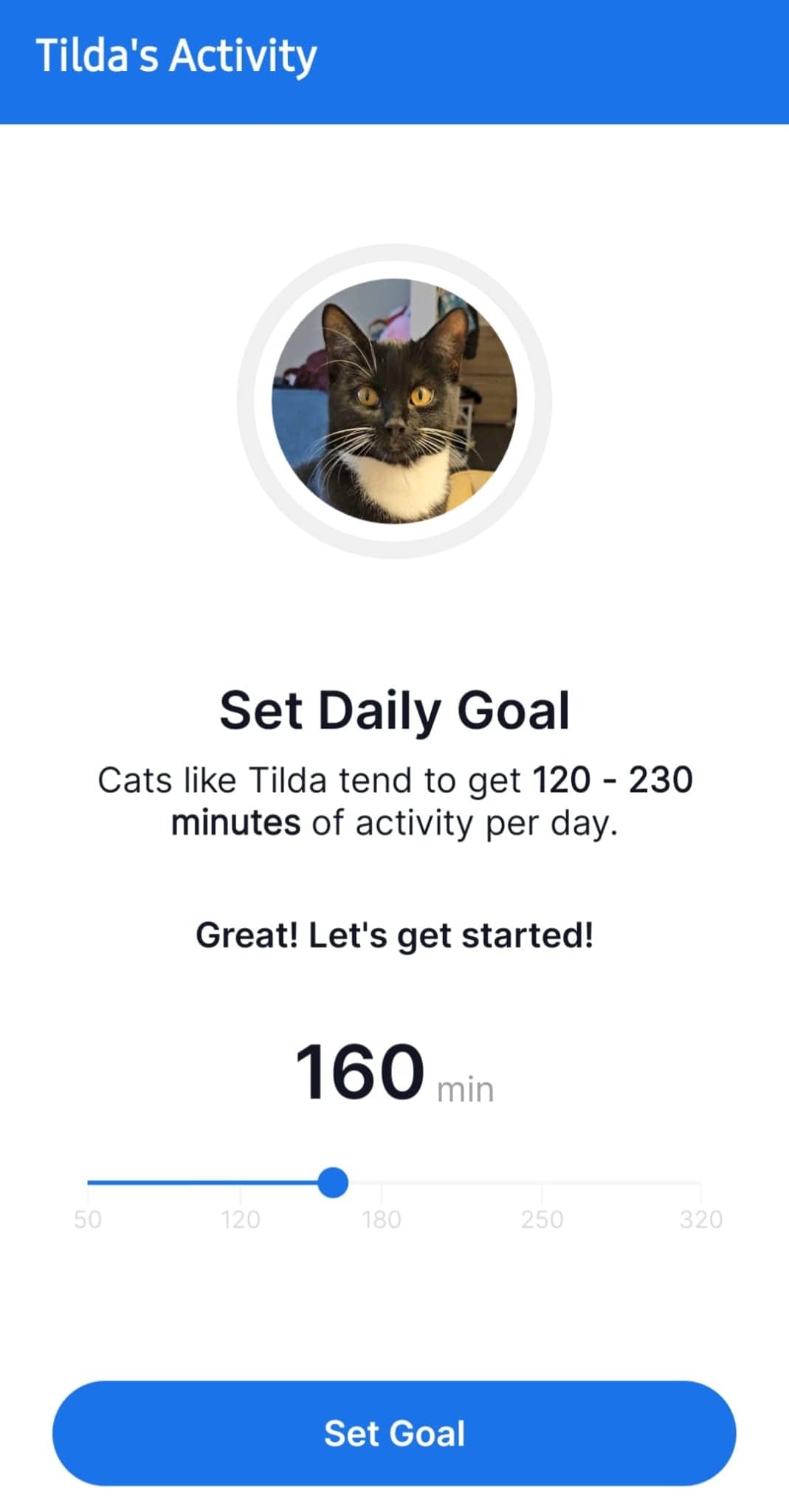
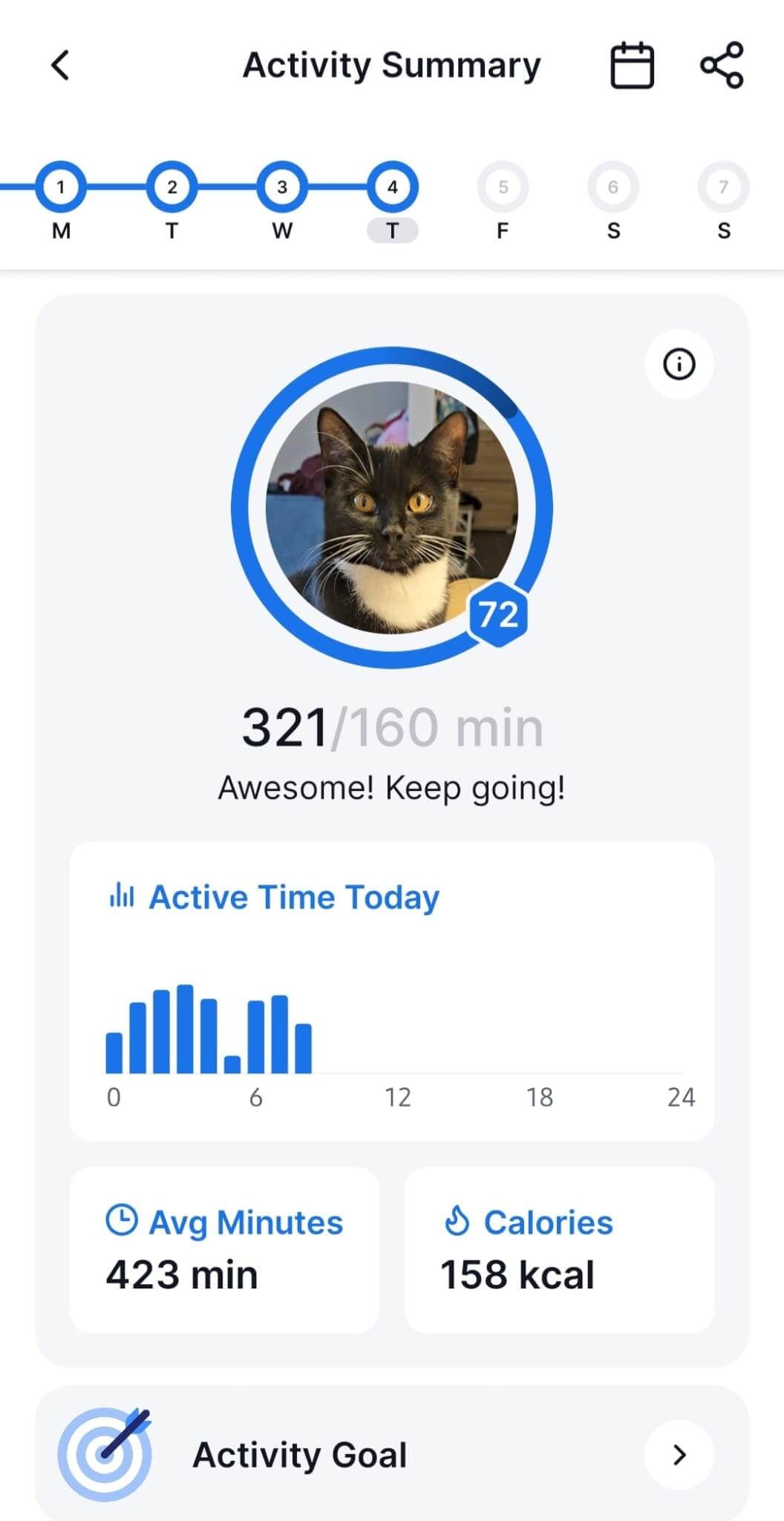
Why exercise matters for your cat’s physical health
Just like us, cats need to burn calories to maintain a healthy weight and prevent obesity. And it’s estimated that around 60% of all cats in North America are overweight or obese2, so this isn’t just a minor concern—it’s a widespread health issue affecting millions of felines.
Regular physical activity helps your cat:
- Maintain a healthy weight which in turn helps to
- Prevent obesity-related diseases like diabetes, arthritis, and heart disease
- Strengthen muscles and bones, which becomes especially important as your cat ages
- Improve cardiovascular health and blood circulation
- Enhance joint health and mobility, helping senior cats stay nimble longer
Read More: How To Help An Overweight Cat Lose Weight
Mental and emotional benefits of cat exercise
Exercise isn’t just good for your cat’s body — it strengthens their mind and emotional well‑being too.
Cats who don’t get enough physical activity may struggle with:
- excessive meowing
- destructive scratching
- restlessness
- anxiety
- depression
Regular activity helps your cat:
- reduce stress and boredom
- express natural hunting behaviors
- feel confident and secure
- sharpen problem‑solving skills
- bond more deeply with you
- sleep better
Cats who exercise regularly even experience less pain from joint disease3. As you can see, there are so many reasons why regular exercise in cats contributes to a good quality of life.
Indoor cat exercise: even more important!
Indoor cats are safer — but they also miss out on natural enrichment like climbing trees, exploring, and chasing insects. Without intentional opportunities to play and move, they can quickly become sedentary.
The bottom line? Indoor cats need exercise every day. It keeps them healthy, prevents behavior issues, and makes life more fun.
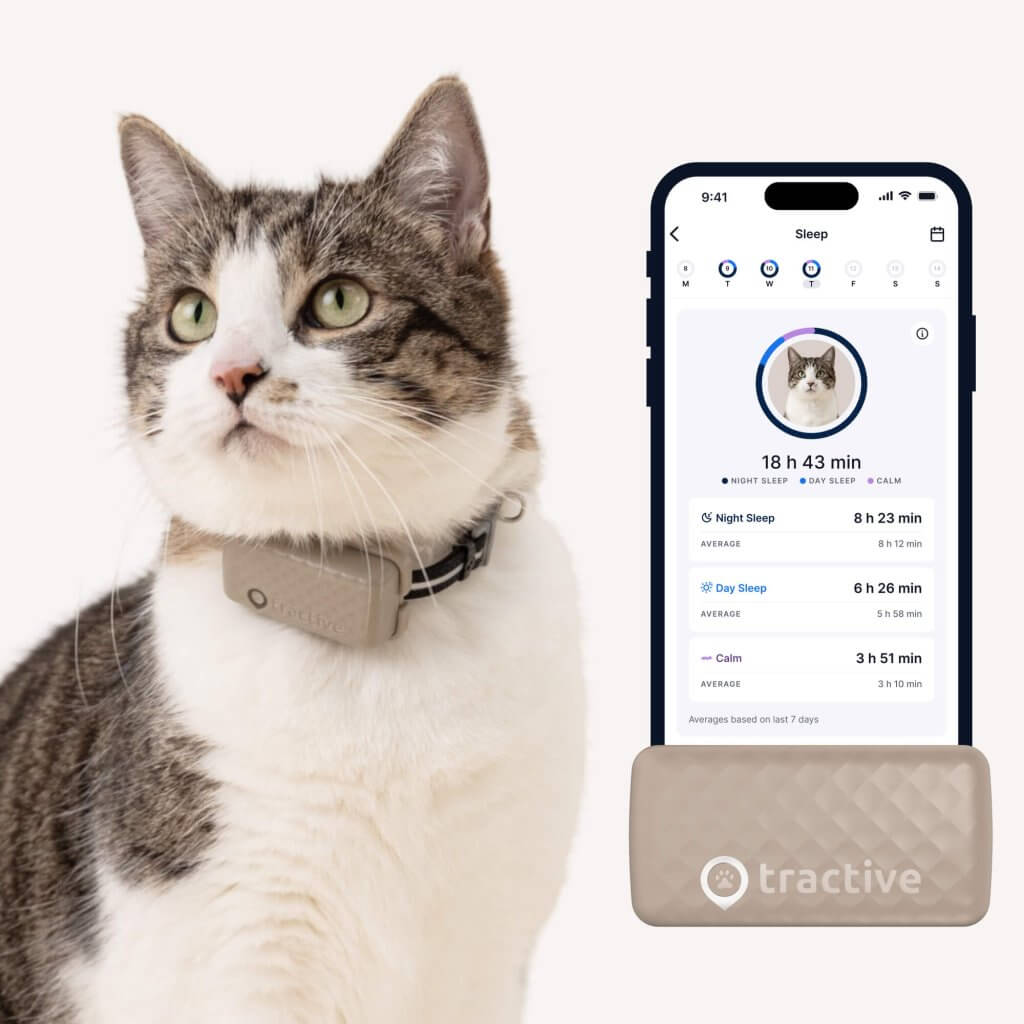
Help your cat stay fit and healthy
Get a complete overview of how much exercise and rest they’re getting. Compare their activity to that of similar cats. Set daily goals.
How to exercise your cat
Good news: exercising your cat doesn’t need to be complicated or expensive. Below, you’ll find dozens of ideas for how to exercise your cat — from simple toys to advanced activities.
Interactive play activities
Interactive play is the foundation of cat exercise—it mimics natural hunting behaviors and strengthens the bond between you and your cat.
Wand and teaser toys
Wand toys (also called fishing-pole or teaser toys) are excellent choices because they let your cat chase and pounce on “prey” while keeping your hands safe from scratches. Move the toy in quick, jerky, unpredictable movements that mimic how a mouse or bird would behave—stop, start, hide behind furniture, and let your cat “catch” it at the end.
Laser pointer chase
A laser pointer can ignite your cat’s playful side with quick bursts of high-energy activity. However, always end laser play sessions by switching to a physical toy your cat can actually catch—this prevents frustration and gives them the satisfaction of a successful hunt. Also be sure to avoid shining the laser pointer directly in your cat’s eyes.
Fetch games
Yes, cats can play fetch! Some cats naturally take to retrieving lightweight toys, springs, or catnip-filled mice. Throw the toy, and if they bring it back, reward them with treats and praise. This encourages running, retrieving, and mental stimulation.
Hide and seek
Play hide and seek using your voice or treats to encourage your cat to find you. This playful activity enhances their cognitive skills and draws upon their natural tracking instincts while reinforcing your bond.
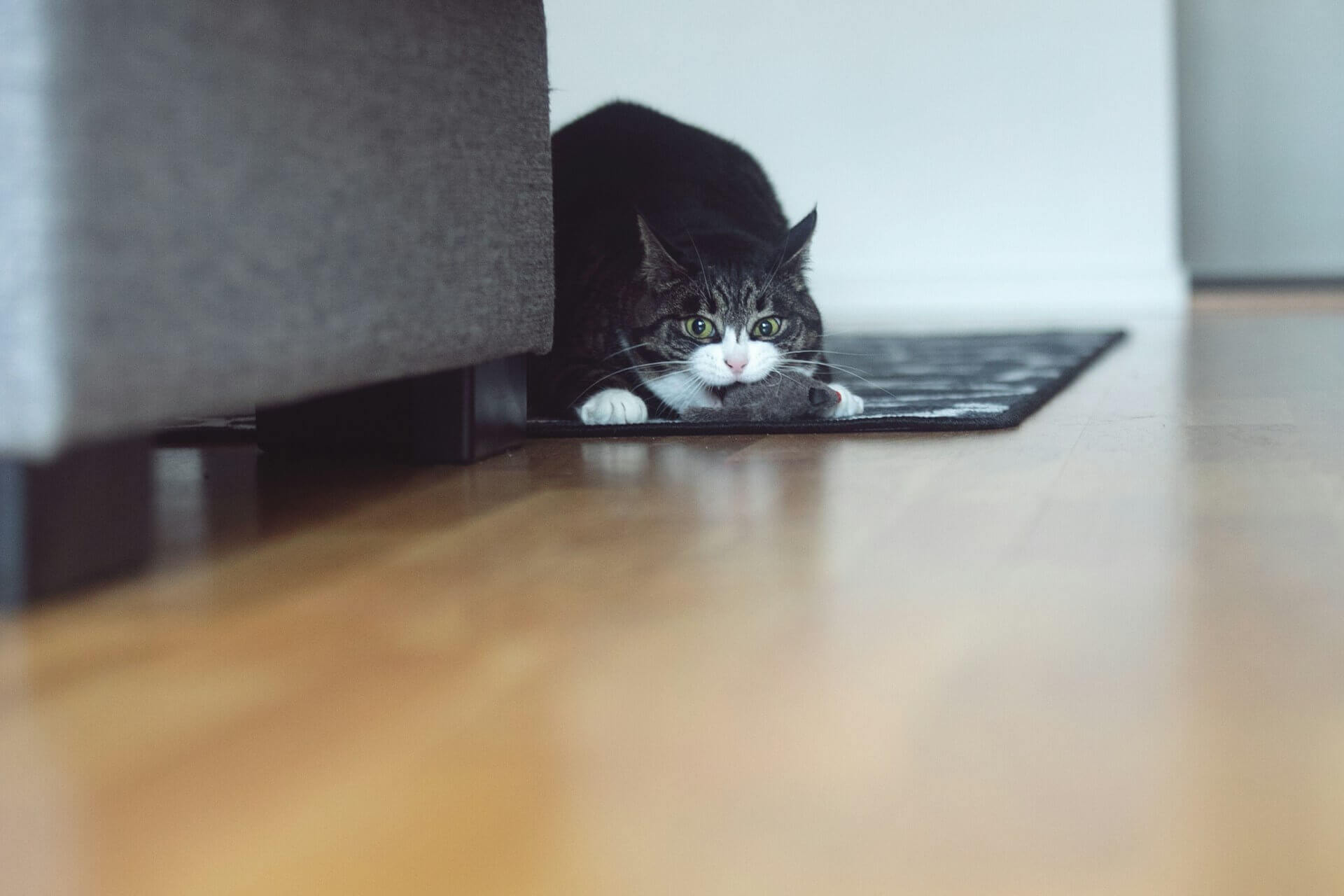
Climbing and vertical exercise
Cats are natural climbers, and vertical exercise is essential for their physical and mental well-being.
Cat trees and towers
Multi-tiered cat trees provide elevated rest and play areas, satisfying climbing and scratching urges while saving your furniture. Look for sturdy structures with varying heights, perches, and integrated scratching posts.
Wall-mounted shelves and “cat walls”
Create a vertical climbing route by installing cat shelves at different heights throughout your home. This gives your cat a way to navigate their territory from above and provides excellent exercise as they jump between levels.
Window perches
A window perch offers sunlight and a safe outdoor view, making bird-watching a mentally enriching activity. Position perches near bird feeders for endless entertainment that engages your cat’s hunting instincts.
Food-based cat exercise
Turn mealtime into an opportunity for physical and mental stimulation.
Puzzle feeders and treat dispensers
Puzzle feeders engage your cat’s natural hunting instincts, encouraging problem-solving and preventing overeating. These feeders come in varying levels of complexity—start simple and gradually increase the challenge.
Food scavenger hunts
Hide treats or kibble around the house to encourage your cat to use their nose and problem-solving skills. This turns mealtime into a mini-adventure and simulates the hunt-and-forage behavior of wild cats.
“Crunchy toss” game
Toss a single piece of food onto a hard floor, stimulating the full predatory sequence of chase, pounce, kill, and eat. This simple game provides both physical exercise and mental satisfaction.
Exploration and enrichment
Create an environment that encourages natural exploration and play.
Cardboard boxes and paper bags
Almost every cat loves cardboard boxes! These simple, inexpensive items provide hours of entertainment. Cut holes in boxes to create tunnels, stack them to create hiding spots, or simply let your cat explore. Remove handles from paper bags for safety.
Collapsible tunnels
Fabric tunnels offer a fun and safe space for cats to dash through and hide. Place toys inside to encourage exploration, and connect multiple tunnels for extended play.
Indoor obstacle courses
Rearrange furniture to create tunnels and climbing routes, or set up a dedicated obstacle course with boxes, tunnels, and perches. This provides variety and challenges your cat both physically and mentally.
Outdoor cat exercise
For adventurous cats, outdoor time offers unparalleled sensory stimulation.
Leash training and walks
Many cats can be trained to walk on a harness and leash, allowing them to explore outdoors safely. Leash-walking provides an extra dose of exercise, and when cats are outside with all their senses in high gear, they come home tired. With a GPS tracker on their harness, you’ll have peace of mind during your outdoor adventures!
Catios (cat patios)
A catio is a secure, enclosed outdoor space where your cat can enjoy the sights, sounds, and smells of nature without the risks. Catios can include ramps, shelves, tunnels, scratching posts, and perches that encourage climbing and movement. You can build your own or purchase pre-made options.
Read More: How To Build A Catio For Your Outdoor-Loving Cat
Yard time
If you have a secure yard, outdoor time allows your cat to explore, climb, and hunt insects safely. Just make sure you have a cat-friendly garden.
Unsupervised outdoor time
If you have an outdoor cat, this is one of the best ways to ensure your cat gets enough exercise. Let them have free range to explore, but monitor their every move with a GPS cat tracker so you can keep them out of harm’s way.
Advanced training and activities
Challenge your cat’s body and mind with structured training activities.
Cat clicker training
Cat clicker training uses positive reinforcement to teach your cat specific behaviors. When your cat performs the desired action, click and immediately reward with treats. This method works for teaching tricks, commands, and even agility courses.
Cat agility training
Agility training is an excellent way to provide your cat with mental and physical activity. Start with basic skills like:
- Jumping over bars or poles – Start low and gradually increase height
- Weaving around objects – Use cones, bottles, or poles
- Running through tunnels – Encourage with treats or toys
- Target training – Teach your cat to touch a target stick with their nose or paw
Once your cat masters individual skills, combine them into a complete agility course. This provides physical and mental workouts that can help cats sleep through the night!
Trick training
Cats can learn impressive tricks that provide mental stimulation and physical activity:
- Come when called
- Sit, stay, and lay down
- High five or shake paws
- Spin or twirl
- Jump through hoops
- Walk into a carrier on command
Start with one trick at a time, keeping sessions to about 15 minutes daily.
Swimming
Yes, really! Contrary to popular belief, some cats can be taught to swim. This low-impact activity is especially beneficial for overweight cats or those with joint issues, allowing exercise with less strain.
Everyday movement and play
Incorporate exercise into your cat’s daily routine with these simple strategies.
Scratching posts and pads
Scratching posts allow your cat to express natural behaviors, keep their claws tidy, and tone their muscles. Provide multiple posts with different textures (sisal, carpet, cardboard) and orientations (vertical and horizontal) throughout your home.
Cat exercise wheels
Similar to hamster wheels but cat-sized, exercise wheels allow your cat to run and sprint indoors. These are especially beneficial for high-energy breeds like Bengals or Abyssinians.
Interactive electronic toys
Battery-operated toys that move unpredictably can keep cats entertained when you’re busy. Rotate these with interactive play to maintain interest.
Simple household items
Don’t underestimate the power of simple toys:
- Ping pong balls – Light enough to bat around safely
- Crumpled paper – Makes satisfying crinkling sounds
- Springs – Bounce unpredictably when batted
- Empty toilet paper rolls – Perfect for batting and pouncing
Play with other pets
If you have multiple cats who get along well, they’ll naturally provide each other with exercise through wrestling and chasing games. This social play is one of the best ways to ensure cats stay active.
Cat exercise tips for special situations
- For Kittens: Kittens have boundless energy and need more frequent play sessions—up to 10 short sessions per day. Focus on play that won’t encourage biting or scratching your hands.
- For Senior Cats: Older cats still need regular exercise, but at a gentler pace. Focus on low-impact activities like gentle play with wand toys, puzzle feeders, and comfortable climbing structures with easy access.
- For Overweight Cats: If your cat needs to lose weight, gradually increase exercise duration and consult your veterinarian about a safe fitness plan. Swimming and leash walks are excellent low-impact options.
- For Indoor-Only Cats: Indoor cats need extra enrichment since they lack outdoor stimulation. Rotate toys regularly, provide vertical climbing options, create scavenger hunts, and consider a catio for safe outdoor access.
Tips for creating a cat exercise routine
- Timing matters: Cats are crepuscular, meaning they’re most active at dawn and dusk. Schedule play sessions during these times for maximum engagement.
- Keep it short: Aim for two to three 10-15 minute play sessions daily rather than one long workout. Cats are sprinters, not marathon runners.
- Read their signals: If your cat walks away or shows no interest, respect that. An interested cat will eagerly participate, bat at toys, and have ears facing forward.
- Always end on a high note: Let your cat successfully “catch” their prey at the end of each session. This satisfies their hunting instinct and prevents frustration.
- Rotate activities: Keep things fresh by switching between different types of exercise and toys. Novelty prevents boredom and maintains interest.
- Stay safe: Never use your hands as toys; always supervise string toys; and ensure all exercise equipment is sturdy and secure.
How a smart cat tracker helps you keep your pet fit
Encouraging your cat to exercise is easier when you can track just how active they’ve been. That’s where technology – like the Tractive GPS Tracker for Cats – can help. Strapped to your cat’s collar, it allows you to:
- Keep tabs on how active your cat is: Including active minutes, calories burned, and distance covered.
- Enjoy a little friendly competition: The Leaderboard lets you see how active your cat is compared to similar cats, local cats, and others around the world.
- Spot potential health issues early: Tractive can also alert you in case there’s an unual change in activity, so you can spot health issues early.
- Track them wherever they go: Finally, if your cat ventures outdoors for some fresh air and exercise, Tractive’s real-time GPS tracking ensures you always know where they are.
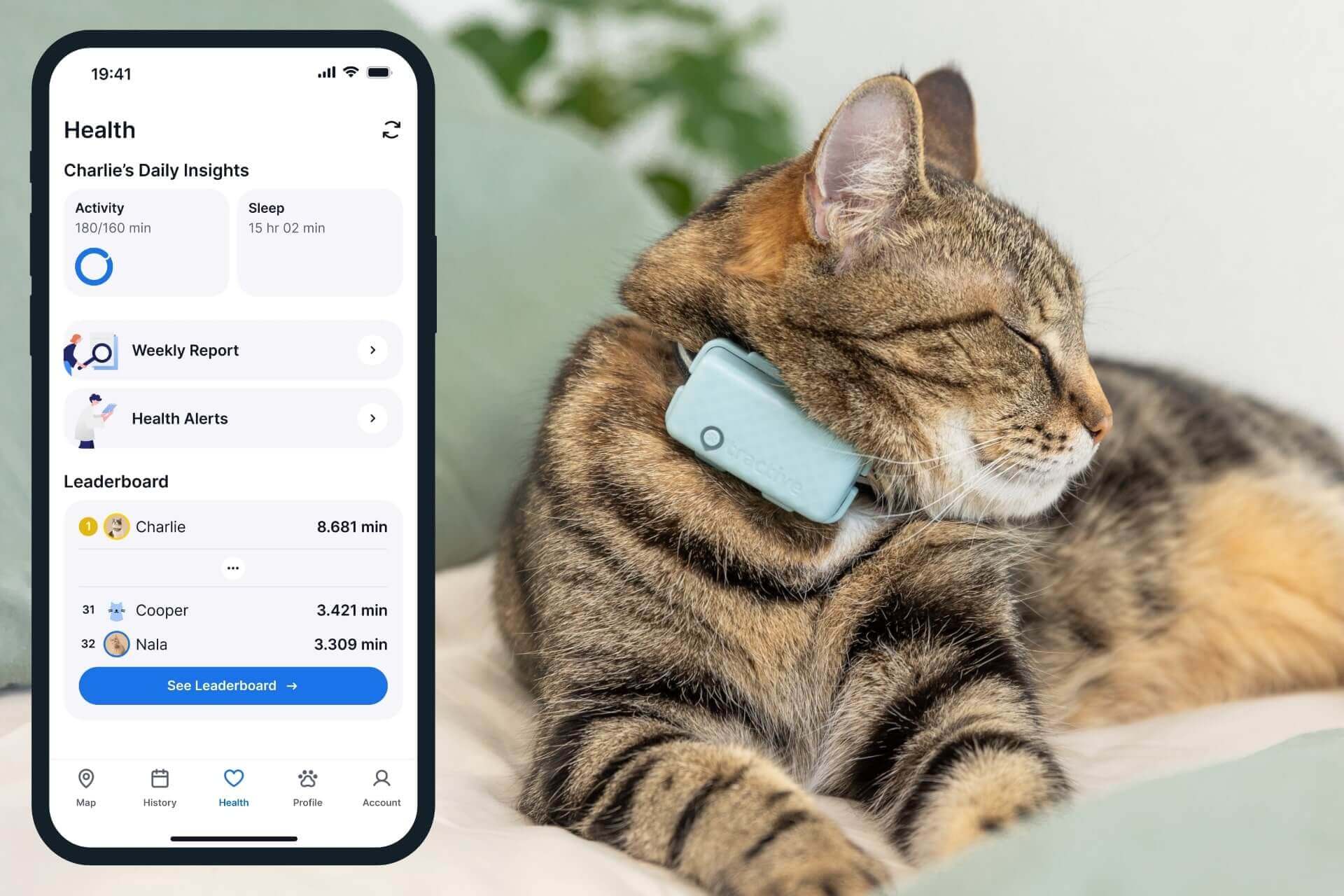
A smart cat collar isn’t just a gadget; it’s a helpful companion that supports your efforts to keep your cat active, healthy, and safe.
The bottom line on cat exercise
Exercise is essential for your cat’s physical health, mental well-being, and overall happiness. Whether you’re tossing a crumpled piece of paper, building an elaborate agility course, or exploring the neighborhood together, every bit of movement counts. The key is finding what your individual cat enjoys and making it a consistent part of their daily routine.



